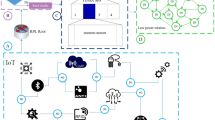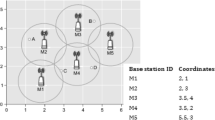Abstract
The Internet of Things (IoT), which builds a large network of billions and trillions of "things” that interact with each other, faces many technological and application challenges. As many devices are interconnected with each other, there is a high possibility of congestion in the network. In critical IoT applications, on-time delivery of packets is important. It is therefore important to minimize network congestion, which can cause delay and packet drop when left unnoticed. Considering the above problem, a Reliable Path Routing (RPR) protocol for congestion control in critical IoT applications is proposed in this paper. To avoid congestion, the next-hop node to transfer the data should be thoughtfully made. For this purpose, the RPR protocol calculates Node Selecting Factor (NSF) based on the buffer occupancy level, interference, path survivability, and congestion level of the next-hop nodes. The node with the highest NSF value is selected to transfer the packets. Furthermore, weighting coefficients are given to each selection criteria out of which buffer occupancy level is given higher weightage than others so it reduces the delay suffered by packets. From the simulation results, it is evident that the RPR protocol decreases delay by an average of 38% and increases the packet delivery ratio by an average of 7% than SPR, SGEAR, CoAR, and CDTMRLB protocols.






source nodes among all the nodes

source nodes among all the nodes

source nodes among all the nodes




Similar content being viewed by others
References
Al-Fuqaha, A., Guizani, M., Mohammadi, M., Aledhari, M., & Ayyash, M. (2015). Internet of things: A survey on enabling technologies, protocols, and applications. IEEE Communications Surveys and Tutorials, 17(4), 2347–2376. https://doi.org/10.1109/COMST.2015.2444095
Atzori, L., Iera, A., & Morabito, G. (2010). The internet of things: A survey. Computer Networks, 54(15), 2787–2805. https://doi.org/10.1016/j.comnet.2010.05.010
Sathya Priya, S., & Murugan, K. (2015). Enhancing TCP fairness in wireless networks using dual queue approach with optimal queue selection. Wireless Personal Communication, 83, 1359–1372. https://doi.org/10.1007/s11277-015-2455-6
Ghaffari, A. (2015). Congestion control mechanisms in wireless sensor networks: A survey. Journal of Network and Computer Applications, 52, 101–115. https://doi.org/10.1016/j.jnca.2015.03.002
Lim, C. (2019). A survey on congestion control for RPL-based wireless sensor networks. Sensors, 19(11), 2567. https://doi.org/10.3390/s19112567
Kafi, M. A., Djenouri, D., Ben-Othman, J., & Badache, N. (2014). Congestion control protocols in wireless sensor networks: A survey. IEEE Communications Surveys and Tutorials, 16(3), 1369–1390. https://doi.org/10.1109/SURV.2014.021714.00123
Elappila, M., Chinara, S., & Parhi, D. R. (2018). Survivable path routing in wsn for IoT applications. Pervasive and Mobile Computing, 43, 49–63. https://doi.org/10.1016/j.pmcj.2017.11.004
Ahmed, A. M., & Paulus, R. (2017). Congestion detection technique for multipath routing andload balancing in WSN. Wireless Networks, 23(3), 881–888. https://doi.org/10.1007/s11276015-1151-5
Gozuacik, N., & Oktug, S. (2015). Parent-aware routing for IoT networks. In S. Balandin, S. Andreev, & Y. Koucheryavy (Eds.), Internet of Things, smart spaces, and next generation networks and systems (pp. 23–33). Cham: Springer. https://doi.org/10.1007/978-3-319-23126-6-3
Elappila, M., & Chinara, S. (2018). Dynamic survivable path routing for fast changing IoT network topologies. In 17th IEEE International Conference On Trust, Security And Privacy In Computing And Communications/12th IEEE International Conference On Big Data Science And Engineering (TrustCom/BigDataSE). IEEE, pp. 92–97. https://doi.org/10.1109/TrustCom/BigDataSE.2018.00024
Jain, A., Pattanaik, K. K., Kumar, A., & Bellavista, P. (2020). Energy and congestion awarerouting based on hybrid gradient fields for wireless sensor networks. Wireless Networks. https://doi.org/10.1007/s11276-020-02439-4
Al-Kashoash, H. A., Kharrufa, H., Al-Nidawi, Y., & Kemp, A. H. (2019). Congestion control in wireless sensor and 6LoWPAN networks: Toward the Internet of Things. Wireless Networks, 25(8), 4493–4522. https://doi.org/10.1007/s11276-018-1743-y.
Benyahia, A., Bilami, A., & Sedrati, M. (2020). CARTEE: congestion avoidance with reliable transport and energy efficiency for multimedia applications in wireless sensor networks. Wireless Networks, 26, 1803–1822. https://doi.org/10.1007/s11276-018-1871-4
Huang, J., Du, D., Duan, Q., Sun, Y., Yin, Y., Zhou, T., Zhang, Y. (2014). Modeling and analysison congestion control in the Internet of Things. 2014 IEEE International Conference on Communications (ICC) IEEE 434–439. https://doi.org/10.1109/ICC.2014.6883357
Fang, Y., Yen, K., Pan, D., Sun, Z. (2010). Buffer management algorithm design and implementation based on network processors. arXiv preprint.
Al-Kashoash H. A., Al-Nidawi Y., Kemp A. H. (2016) Congestion-aware RPL for6LOWPAN networks. Wireless Telecommunications Symposium (WTS) IEEE https://doi.org/10.1109/WTS.2016.7482026
Li, M., Jing, Y. (2012). Feedback congestion control protocol for wireless sensor networks. 2012 24th Chinese Control and Decision Conference (CCDC) IEEE 4217–4220. https://doi.org/10.1109/CCDC.2012.6244675
Chang, E. J., Hsin, H. K., Lin, S. Y., & Wu, A. Y. (2013). Path-congestion-aware adaptive routing with a contention prediction scheme for network-on-chip systems. IEEE Transactions on Computer-Aided Design of Integrated Circuits and Systems, 33(1), 113–126. https://doi.org/10.1109/TCAD.2013.2282262
Chen, S., & Yang, N. (2006). Congestion avoidance based on lightweight buffer management insensor networks. IEEE Transactions on Parallel and Distributed systems, 17(9), 934–946. https://doi.org/10.1109/TPDS.2006.115
Sheu J.P., Hu W.K. (2008) Hybrid congestion control protocol in wireless sensor networks. VTC Spring 2008-IEEE Vehicular Technology Conference IEEE 213–217. Doi: 1109/VETECS.2008.56
Wang, G., Liu, K. (2009). Upstream hop-by-hop congestion control in wireless sensor networks. 2009 IEEE 20th International Symposium on Personal, Indoor and Mobile Radio Communications IEEE 1406-1410. https://doi.org/10.1109/PIMRC.2009.5449877
Aimtongkham, P., Nguyen, T. G., & So-In, C. (2018). Congestion control and prediction schemesusing fuzzy logic system with adaptive membership function in wireless sensor networks. Wireless Communications and Mobile Computing. https://doi.org/10.1155/2018/6421717
Chakravarthi, R., & Gomathy, C. (2010). IPD intelligent packet dropping algorithm for congestion control in wireless sensor network. Rendz in Information Sciences and Computing (TISC2010) IEEE. https://doi.org/10.1109/TISC.2010.5714644
Chughtai, O., Badruddin, N., Awang, A., & Rehan, M. (2016). Congestion-aware and trafficload balancing scheme for routing in WSNs. Telecommunication Systems, 63(4), 481–504. https://doi.org/10.1007/s11235-015-0126-2
Chen, T.-Y., Wei, H.-W., Lee, C.-R., Huang, F.-N., Hsu, T.-S., & Shih, W.-K. (2013). Energy efficient geographic routing algorithms in wireless sensor network. Journal of Interconnection Networks, 14, 1350001. https://doi.org/10.1142/S0219265913500011
Haight, F. A. (1957). Queueing with balking. Biometrika, 44(3/4), 360–369.
Sun, D., Huang, X., Liu, Y., & Zhong, H. (2013). Predictable energy aware routing based on dynamic game theory in wireless sensor networks. Computers and Electrical Engineering, 39(6), 1601–1608. https://doi.org/10.1016/j.compeleceng.2012.05.007
Bhandari, K. S., Hosen, A. S. M., & Cho, G. H. (2018). CoAR: Congestion-aware routingprotocol for low power and lossy networks for IoT applications. Sensors, 18(11), 3838.
Author information
Authors and Affiliations
Corresponding author
Additional information
Publisher's Note
Springer Nature remains neutral with regard to jurisdictional claims in published maps and institutional affiliations.
Rights and permissions
About this article
Cite this article
Pushpa Mettilsha, J., Sandhya, M.K. & Murugan, K. RPR: Reliable path routing protocol to mitigate congestion in critical IoT applications. Wireless Netw 27, 5229–5243 (2021). https://doi.org/10.1007/s11276-021-02805-w
Accepted:
Published:
Issue Date:
DOI: https://doi.org/10.1007/s11276-021-02805-w




